IRVINE, Calif. — Amid the devastation of the COVID-19 pandemic emerged new scientific revelations, ones that drug makers expect to speed cures and treatments for illnesses like hepatitis and even HIV. And with that technology, companies — even small ones — are betting on big rewards.
The University of California, Irvine hosted a collection of researchers this spring who were among the thousands who developed everything from effective tests for COVID-19 to the vaccines themselves.
The technology in question is Messenger RNA, a revolutionary delivery system created through major contributions from Phil Felgner, director of UC Irvine’s Vaccine Research and Development Center. The technology helps to fortify the body against viruses by teaching it to wall off the illness with proteins produced by cells. It’s essentially using the virus’s own strategy against it.
The pandemic helped supercharge the final stages of development through former President Donald Trump’s Operation Warp Speed.
Felgner was on the panel along with Drew Weissman, professor of medicine and director of vaccine research for infectious diseases at the University of Pennsylvania.
Both have been involved in the technology's development or its application with other vaccines. They say it could be the next big thing in pharmaceuticals.
The noted science journal Nature reported that the combined valuation of five companies using mRNA jumped from $15 billion in 2019 to more than $300 billion once the pandemic was underway.
“This boost in valuation reflects optimism that mRNA technology can deliver much more than the current prophylactic COVID-19 vaccines, and perhaps also expectation that COVID-19 is here to stay,” the journal wrote.
The pandemic and the billions of vaccines that have since been delivered have been a crucial proving ground, paving the way for newcomers. And UC Irvine even signed a research agreement with international biotech company Polaris to use its mRNA vaccine on influenza and coronavirus.
“We were thinking 35 years ago, this would happen,” Felgner said.
A company called Strand Therapeutics is developing mRNA medications for uses in oncology, highlighting the versatility of the technology.
MRNA has three major uses: prophylactic vaccines, therapeutic vaccines and therapeutic drugs. But not every company will have expertise with each or staff familiar with both the technology and whatever illness they want to target.
“You have to collaborate,” Weissman said. “You may be good at mRNA research but not good at HIV research. The irony is [mRNA] is available to anyone.”
That means, Weissman added, that there will be a flood of new products. Also, the number of new companies developing their own products has exploded. Weissman said he knew of about half a dozen companies using mRNA before the pandemic. Now, he can’t count them all.
But the revolution has already begun, with a host of companies ready to find new ways to heal people, earning these businesses new revenue. Meanwhile, the coronavirus is likely to continue funding vaccine makers for the foreseeable future.
“Next time we need a vaccine, we’ll have the ability to produce one in maybe 10 months,” Weissman said.



